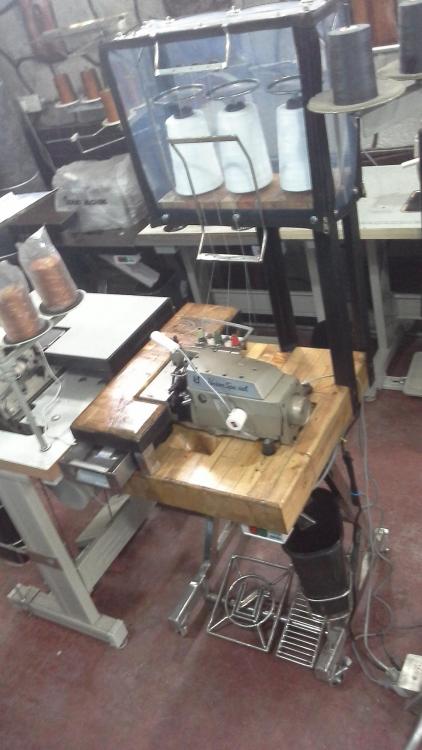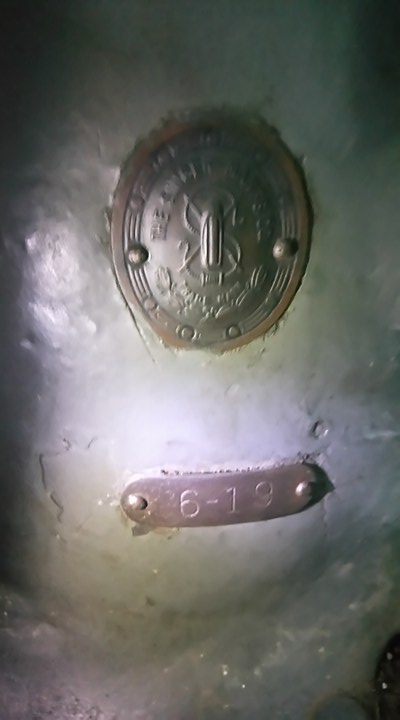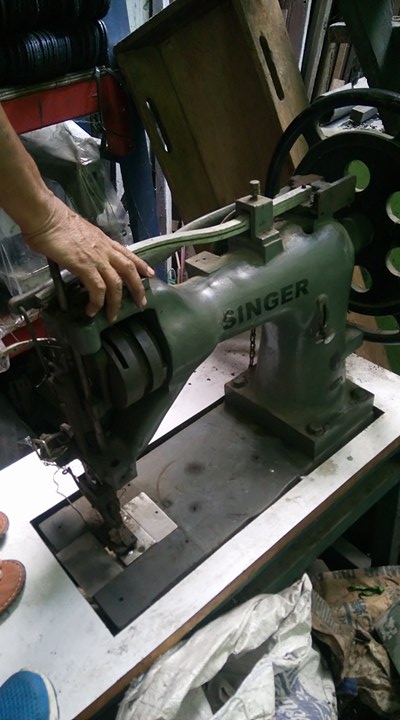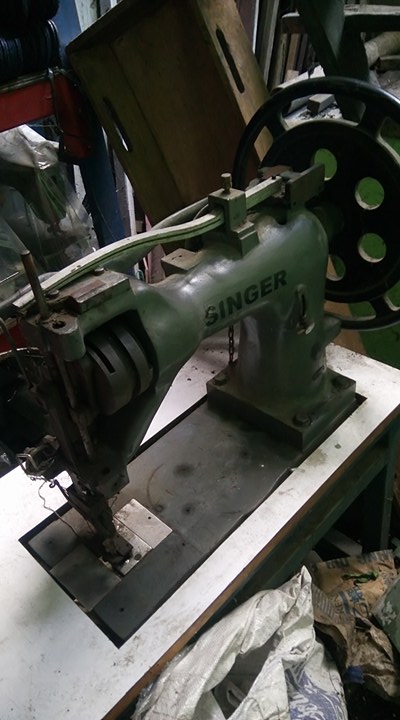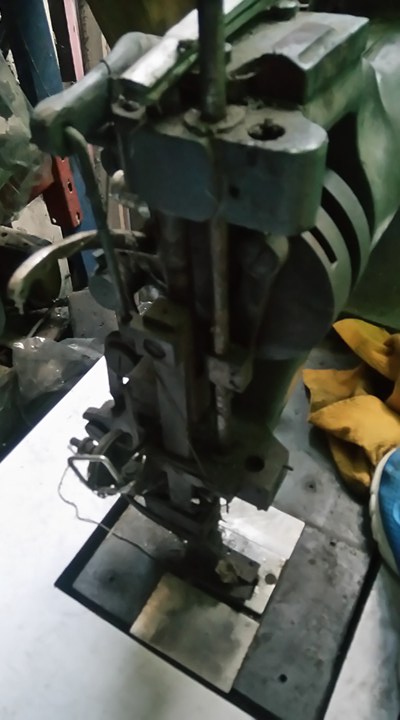
ke6cvh
Members-
Posts
75 -
Joined
-
Last visited
Content Type
Profiles
Forums
Events
Blogs
Gallery
Everything posted by ke6cvh
-
Hello group, We are using a recently overhauled circa 1915 Singer 45k1 allot lately and love the machine for heavy type work with webbing, canvas, and denim. I took the low road and got a locally available 750w brushless servo as the price was just over 100 dollars in this country. It is nice enough but I've seen problems with this band of motor wanting to chug along at the lowest speed. Lots of messing around got it to work properly again and I noted the problem went away when I messed with the needle up/down button. My assumption is that the circuit board/microcontroller circuitry is confused thinking it needs a sensor input so it is hunting and waiting for the sensor to tell it to stop. This was partially confirmed by shorting two pins on same connector as the sensor resetting it. So I spent under 20 US dollars (850 pesos) and got a sensor and hooked it up. Well the motor no longer gets confused with the up/down sensor button. However the heavier weight of the flywheel allows it to freewheel past the up or down position hahaha. Inertia and needle position sensors just don't seem to be made for one another. I thought this motor had a brake on it like the ones that Bob Kovar sells but it seems to not be the case. Anyone have similar humorous but not so good experience with motor position sensors? Best regards, Mike
-
Hello group, I am the proud owner of both a 16-188 from 1954 and a 16-88 that is over 100 years old. We lovingly restored the 16-88 with cold cure japanning. That machine is awesome for upholstery type work. We sew multiple layers of material such as canvas and denim but also clear vinyl when we made some of our machine covers. The 16-188 gets a little neglected because of space issues and it just aint as beautiful as the older machine that runs smooth as can be. I looked for larger needles on eBay and the largest I could find for this machine was a size 22. They may have made a larger one (if so please let me know as I'm looking for size 24 and might as well go for 23) but since I cannot find larger than 22 maybe it isn't made anymore. I believe it would be great for other light work but need a size 24 needle etc... Mentioning this on this post as a potential limitation of the machine. Our 45k1 from 1915 on the other hand is not a walking foot but can definitely handle the heavier thread and needles with anything a harness machine might need to sew. Best regards, MIke
-
it is likely going to be on the cast iron somewhere. It was common to have an oval shaped piece in the casting. You can then go to the ISMACS site for serial numbers and try to cross it to a date. The 460 is a later model preceded by machines like the 246 series. That is why I guessed it to be around 1960 time frame but that is only a S.W.A.G. It is certainly going to be a self oiler being it is capable of up to 6500rpm. I do not have personal experience on this machine but the basics are pretty fundamental. Anyone used to 3 thread machines would certainly be able to figure out fairly quick the threading. If you have to break the case open (unlikely) you would be able to easily make a new gasket for it and seal it again. If it is like a Merrow there will be a plunger pump on it. The Merrow m-3dw-4 I have here actually has two plunger pumps and a filter but I did not need to break the case. It was semi-frozen upon receipt. I moved it back and forth to free it up. I then filled it with kerosene (light lubricant) and ran a belt off the chuck of my Dewalt 10 amp drill for a while. THen drained and put Juki M oil in it (light machine oil). The manual called for light turbine oil but my experience is this is ok. The manual specifically stated to not use stainless white oil (mineral oil with possibly some inhibitors like the Shell Diala used in power transformers). On the other hand our Union Specials use mineral oil. In the end an older machine like this would likely never be run at 6500rpm anyways and taking it down a notch or two to 4-5k rpm should be just fine. I see loopers and knifes on eBay for this machine. I had an old guru teach me the trick to sharpening the upper knife. It is done in one direction only. We did this to our Merrow before we got new knifes for it. My wife was using our Merrow and our Brother the other night. She now only uses the domestic Juki for light work and not as often. I'm happy to see her using the industrial sergers more and more. They are true work horses of the garment industry. Looking I see there was a "K" on some models. The K is for machines made in Scotland. The W's were in USA. Best regards, Mike
-
forgot to ask...what is the serial number? It is pretty easy to cross date of mfg. with most Singers based on serial numbers using the ISMACS website. Not all industrials can be narrowed down really well but typically it can be found. For example, our 112w-139 and 112w-140 both are mfg. in the 40's but I can't nail down the exact year because "W" machines (industrials) are not as easily found all the time. Just curious but my S.W.A.G. is that this machine likely is around 1960. Would be fun to find out. Best regards, Mike
-
OK, on the threading. Here is a video in Spanish that shows the threading. Really doesn't need to be in English as it is shot pretty good. I see the 460/13 in this video uses a curved needle. Our Merrow and our 39500's use curved needles. Our US39800, Juki, Brother, and Singer 1842's use straight needles. The advantage to a curved needle like yours is that the needle enters into the stitch triangle easier (it is much easier to adjust loopers if ever needed) and curved needles are more precise as well as likely faster but what I do know for certain is precision needle placement and ease in adjustment. The trade-off is that the needles are more expensive and have to be ordered off the net. I prefer curved needles most of the time. If you search youtube you will likely find more videos showing the threading. Best regards, Mike
-
Check this video out....person took a simple sewing machine motor for a domestic machine and mounted the Singer 460 series to a portable plywood base that is picked up and set on a table when needed.....not bad and very simple and effective. Ebay has these universal motors super cheap...or you can just chop your table in your picture. We have done that also. To the left in the other pic posted is our Juki mo-3300 industrial 4 thread barely can be seen. We took a cheap Chinese (sorry Juki but you don't deserve the TLC our Union Specials get for tables) table and mod'd it to be 2ft wide. Best regards, Mike
-
Hello again, OK....I can't help myself when you mentioned a space issue. Here is a picture of a Union Special 39500rf (that is heavy duty with a high throw which is a good thing). It is likely bigger than your 460/13. Merrow makes a table they are quite proud of that is 24 inches wide and is pretty "plain Jane". This table is 19 inches wide, has foot pedal for presser and the servo motor, enclosed thread stand with our own engineered thread cone caps, easy access with zippers and snaps to the thread cones, curved opening with stainless chute into waste bin. Merrow has none of these features and is overpriced....eat your heart out Merrow! We made the butcher block from scrap 2x4 and made it end grain on the fold out section (I don't think Merrow's table has that either and a Merrow is much smaller footprint as a machine) and end grain on the thread stand. Everything on the table itself is stainless and the thread stand is angle iron. So, if you have 19 inches of space and want to keep your machine it can be done! Because this 3 thread is used for piece work we really don't need space to the left but other similar tables (with built in logos for other makes) do have space to the left. Those tables are huge as they are 24 inches wide. I have a Union Special table that is different design up on youtube but the table was not completed with chute and other items. Video does show the stainless drawer like this one (partially pulled out in picture and the shape is unique because of the size of table....drawer is longer on left for scissors and internal divider allows smaller items like thread scissors as it fits around machine when pushed all the way in) which when pulled out allows access to the loopers and threading. Some of our Union Special sergers are definitely 1970's vintage. Unsure about this one as it could be decades old but it really doesn't matter as it works awesome. American Made at it's best and still being mfg. today in USA. Best regards, Mike
-
Here is a free .pdf link for the maintenance of the machine and description of options/stitches. This one does not show threading but that will not be all that difficult to get figured out. I'll look for that next as there maybe some tricks (like there is on the Merrow). The sub-class 13 can be set up for a purl stitch by changing loopers and springs as well as different spi by changing eccentrics (this is common). The thing to know about sergers is that they are strong because the stitch can stretch. 4 thread is stronger than 3 thread. 3 thread is typically used when strength is not necessary but edge finishing is needed and also where curves might need to be done such as a zipper etc. Sergers (means it cuts and it overlocks kind of like the blues brother's movie where they sang Country and Western) become different when it comes to fine material. This machine is likely a 1/8 inch width which is just fine for denim IMHO but if you are trying to do a semi felled seam then you would likely prefer a wide 5 thread (so it can easily be folded over for top stitching). We use our 3 threads allot and have them set up with large cones of white thread. We use our 4 thread when it is straight and we need the strength but don't need the safety stitch (the 4th and 5th thread/second needle chain stitch on the 5 thread machines)This may change in the future but our other sergers are set up with either gold or grey thread (we will set one up for each color if we have multiple units which we do). One thing you must be very very careful of with a machine that has loopers is thread path. Light tension on the looper threads is the norm and if you have inconsistent feed path it will result in broken threads and agony constantly rethreading. We have our own stainless thread cone caps we engineered here for this purpose and they are great! Best regards, Mike http://parts.singerco.com/IPsvcManuals/460_CLASS.pdf
-
Hello group, I thought I'd seen a youtube video on this class machine and searched...here it is. Singer 460-13 in operation. Best regards, Mike
-
old sergers are just fine.....we have five Singer 1842u092-6 five thread extra heavy duty and wider version, one Brother ma4-b551 medium duty five thread, one Juki mo-3300 series four thread that is a jewel, one Merrow m-3dw-4 from 1963/64, one Union Special 39800cp five thread, one Union Special 39800ap four thread, three Union Special 39500rf's with one getting ready to be converted to a zipper foot with 39520 foot for that just arrived and some tweaking on the presser bar/needle plate etc, one Union Special 39200at from the 1920's so that is 14 industrial sergers and an old Singer 360 or 460 would be just fine around here as ALL of our sergers are jewels and work just fine all day long. IMHO just keep it and maybe you will find a project or two it can be used on. The 460 is not going to be as heavy duty as the Union Specials but it is an industrial so it will be ok. I read a blog where someone was complaining about Union Special 39500's and was a designer of clothes. Person could not figure out how to thread it and was complaining about having to use a threading tool. Basically, they were wanting a home serger (oh I forgot we have one of those also a Juki mo-654de if I remember the nomenclature but I never touch it...it is for the Mrs. as a simple and reliable go to machine that will eventually and surely bite the dust if used allot). I answered that blog...the 39500 is still made in USA and with an external oil cooler and pump it can do 9,000 rpm's! Just watch a youtube video of that machine in a factory setting and it can be appreciated. Our Merrow is loved and cherished here. They say the cams on the new ones will work for 30 years continuous usage. Once again I recommend keeping it around if you have space. We have had to work on some of our sergers before but it always has been minor. The Union Specials are designed to be rebuilt. Best regards, Mike
-
I read another post on leatherworker.net where someone had stated they contacted Luberto and was told that it would not be economical to upgrade a machine so that the feet can be moved from left to right so one may be stuck with a fixed foot without some serious machining skills at hand. The ebay auction seller has zero feedback which is something that can be a hindrance for new folks on ebay. Also, the auction does not state willingness to crate and ship to addresses in USA. This is likely due to inexperience on eBay. Good price but I am still researching and learning about the Luberto. It does not have reverse. However, made in USA and looks to be extremely well built. Watching youtube videos it uses a shuttle hook assembly for a 45k so I'm assuming the needle is a 214x type but someone please correct me where I am wrong about that as I cannot find yet where it states the needle it uses. With that said max needle size for the most part would be size 27 but I have seen new old stock of size 28 and "out of stock" in size 30. The only thing that would get one, in my near zero experience, is possibly a braided size 415 instead of the poly bonded size 415 Cowboy brand. I ordered some braided and hope it fits into the size 28 needles I ordered otherwise it will be limited to other uses like hand sewing. If anyone knows the needle that would be good info. Best regards, Mike
-
Can anyone tell from the pictures if this is the model that allows the needle/foot to move from side to side? I have read that older models of the #9 did not have that function. Also, I see the guide foot is not on the machine. Best regards, Mike
-
Good morning! Sorry about the late response am 12 hours off EST. I edited my comment above before hitting the sack for the night as a friend emailed me and mentioned the motor for the air compressor. You have taught me allot about the 7 class machines. I'd suspected the 7 class machines might be very similar to the 6 class. Had also wondered about the larger portion of the wheel in the first drawing and now know about the clutch. I can get something machined (if someone hasn't already) for the new area to accept a groove for M type belt coming off a servo. Was wondering why the rear of the machine was not included in pictures and now think that is likely because someone made changes to it. Also, thanks for giving me an idea of it's worth as a book machine that will need types of conversion. I'll let you know but suspect they will ask between 150 and 250 dollars. Let's see. There is a model 7 in Manila but I only saw it very briefly and did not have a flashlight so don't know what sub class I just know the hand wheel would not turn. The owner of that machine has some various machines from his deceased Uncle sitting around in his warehouse of machines and believes it brings him good luck so refuses to sell (but he did sell me my 45k1 that also belonged to the deceased uncle). Will keep you updated. Best regards, Mike
-
And here is the last of the pictures I can get for now (it is midnight and all that was sent to me). Best regards, Mike
-
Sorry, but I can't help myself....in the drawing you submitted there is a motor on the side so the "hand wheel" is more of a flywheel. In the picture can barely be seen a round section on the other side of the machine but there is no motor visible or cutout for belt. The table base is same color of green as machine. Best regards, Mike a friend just emailed me with a correction that the motor on the side is for a compressor to blow out the stuff related to the drilling operation which is not used in this setup having been removed I guess and the giant spring is likely for compressing any books he thought. So, a picture of the back side will be asked for tomorrow to see the motor setup. I'll change it to a servo if the price is right and it is bought.
-
Hi thanks for the response. Yes, the 6-19 is for books but there are others in the same class made for heavy work in leather, canvas, and paper according to the general class description. I'm waiting for an answer but my experience buying machines here (Philippines) is that the agent who helps me is amazing and gets amazing deals for me. I get machines at prices that just aren't quite right at times. For example we have an assortment of double needles some from USA and others local. I got our two Juki 3168 split bar double needle machines with table and servo motors at about 400-500 dollars each and even less for the fixed bar 3128. On the other hand the 112w's we only bought from USA. I'm betting on a crazy good deal and will find out tomorrow. I see that in the description for the 7 class machine on ISMACS when it describes the shuttle it states "not as heavy as 6 class" so this must be one heavy duty machine. I just am finding zero information on this machine anywhere. It must be rare for sure. If it is tight, nothing missing (that I need) or broken I might pull the trigger on it. I have to wonder what is on the back side of that giant wheel. I'm attaching another picture that shows the table with it.....where is the motor is this thing set up for hand crank? Maybe the motor sticks out the back of the table and the belt is exposed? It just looks like a strange set up from the pic's. Best regards, Mike
-
Hello Group, Thumbnails is all I could get and it posted before I could type. There is a potential seller of this Singer 6-19. At first I thought after reading ISMACS it was fixed stitch length but saw a picture with a variable stitch length control so it appears same as others in the class. ISMACS has it as a book binding machine but others in the class are a harness machine which is what I'm looking for. This variant has ISMACS listing a 6x15 needle and the only one and states it is a drill first machine which made me wonder if it is some version of a needle and awl? My pretty un-educated guess on leather machines is that I can reset needle bar height and use a 7 class needle such as a 7x1, 7x2, 7x3 and maybe even a 214x2 needle? Anyone know anything about these machines and willing to enlighten me please let me know. I'm waiting for confirmation of willingness to sell and price. Best regards, Mike
-
Hello again group, I found a facebook user group for shoe making that I am waiting for approval to join but they had a Frobana manual scan (in German) that I downloaded for free. I also found a lot of 10 pieces and another of 9 pieces of nm240 needle on Ebay out of Germany. The Tippmann industrial web site states the following: 346 Thread with a Size 230/250 Needle Commonly used for mule and other heavy duty tack. Also used in boot and shoe applications. So, it seems I may have hit pay dirt on this one. Now I need to find some T346 thread and also figure out if Schmetz is still making the 761 pg needle or not (this is the Frobana needle I bought). Please email me or pm me if you want a copy of the manual. There is also a pristine copy on ebay in German but this one will get the job done and already in digits. Any feedback on a Gritzner Frobana is welcome of course. If this machine works for the intended purpose then it will eventually become a manual back up with a different machine as the primary. Happy holidays and best regards, Mike Kendall
-
Hello group, I purchased a Frobana. This is an older one that was imported to New York. From a different posting on the internet someone was guessing 20's to 30's. It still has waxed thread in the bobbin and the spool (spool has a very cool hot-rod or aircraft brushed finish to it on the thread). The heater for the wax on the bobbin appears completely intact as I took it apart and carefully re-assembled. However, with pre-waxed thread it seems nobody was using the wax pot. Thread was too old and breaking too easily so I discovered that 100 percent carpet warp is the same diameter (but not allot stronger it seems) and I got it to sew a 4mm crepe type rubber onto denim. Very cool machine. I also see that there is some nylon available at Ace hardware that is same diameter so this will likely be my go-to for strength but not sure if it will be easier or harder to sew with nylon. I'm hoping to get an operator's manual in English and willing to pay for a scan but I'm thinking that is unobtanium....if anyone wants/willing to help there it would be of great help. My intended purpose for this is sandals and more importantly for sewing knee pads onto work jeans. I have some 4mm (with grooves) 50a durometer "Genuine Grip" that I"ll be trying. My thought is with this softer rubber I will certainly need the thickest possible thread possible to keep from tearing through the rubber. It only has 1 needle. I see more on ebay out of Germany. Is this a needle no longer made? The needles on ebay are size 4 and size 5 but this cotton carpet warp thread is a ticket 4 (just a S.W.A.G. as I don't know how to properly guess that one). Is there a way to nail down the size of this needle? Are people making them by bending then heat treating? Any help would be very much appreciated. Happy holidays. Mike
-
Yes,. If one looks on Amazon there are recycled tire sandals. Anything of quality is too much money imho. I was aware of the VietCong combat boots. I guess a more specific question would be about sewing through the tough 1/4" thick layer of rubber, middle layer of eva foam, and top layer of insole material,. I don't want to buy a machine and find out that it is the wrong one. Best regards, Mike
-
Hello Group, I have been working up to a hand woven denim biz using a countermarch loom so have purchased some possible machines already suitable for leatherwork. I originally just wanted to make a very custom leather label to sew on the back. Have here a 16-188 but read in some of the informative posts it may scar the leather. Am in the process of buying a 212w-139 also. Then decided to also make sandals using recycled tires with eva foam in center (same as puzzle foam from dollar general) and another layer on top of that which will likely be a layer of leather. I have a cnc mill and am researching the best way to mill the rubber tread pattern. Machining the rubber will require some special applications and no easy task but once a technique has been completed that portion will be easy enough. I am retired US military and now a stay at home dad so this all is in line with a home business. So, the plan is to sew the three layers comprised of leather, eva foam, and rubber together but there also will be glue. The machining process will result in a channel in the bottom tread that will allow the thread to not make constant contact with the ground while sandals are worn. Someone wants to sell me an antique Frobana but I read it takes curved needles that I do not know where to get and uncertain if this will be reliable. Wanted to get a Singer shoe patching machine but read 4mm maybe 6mm max sewing and not sure if this is a good solution as I will likely be over that thickness. Any suggestions would be greatly appreciated. Best regards, Mike Kendall


